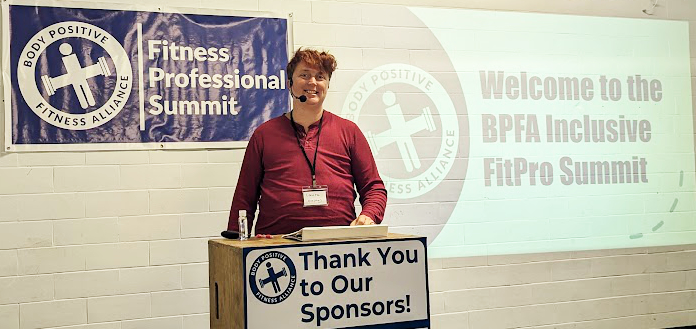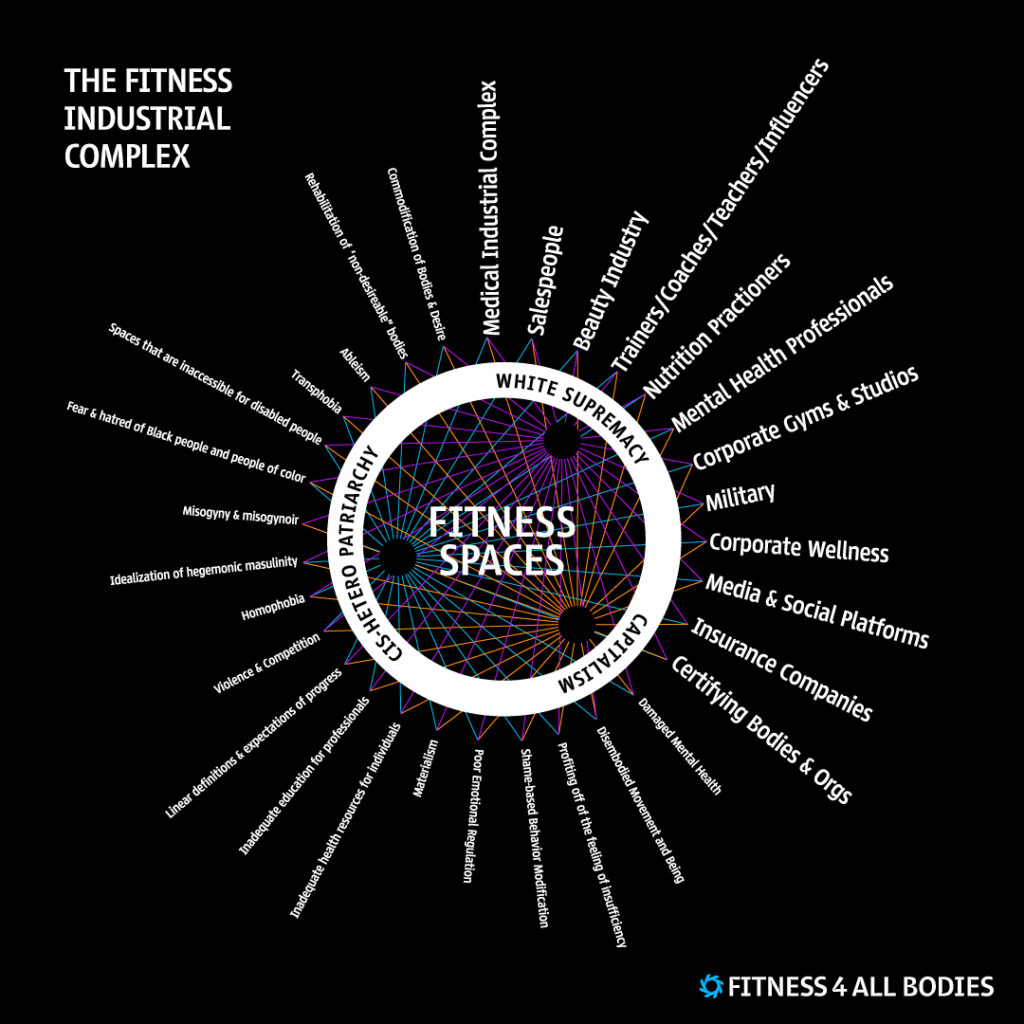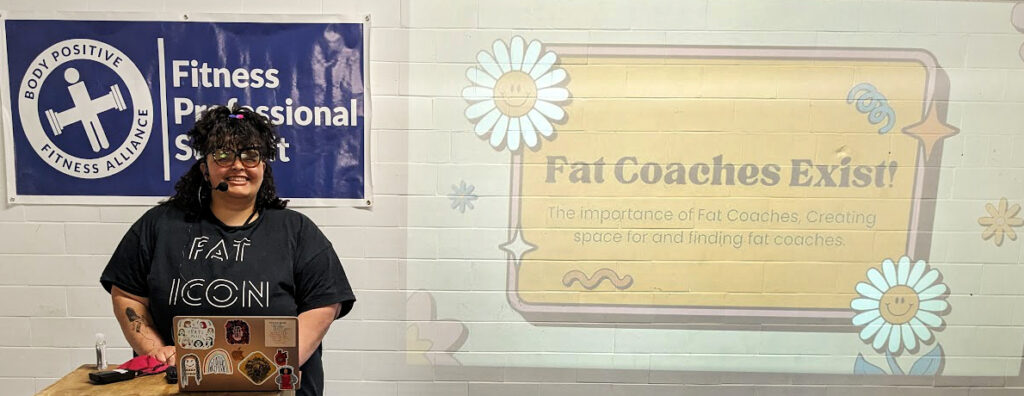On May 18th and 19th this year, I was in Philadelphia attending (and presenting at!) the Body Positive Fitness Alliance’s Inclusive Fitness Professional (FitPro) Summit. While it’s mainly a conference for people in the fitness industry, I wanted to pull back the curtain and tell you about some of the things we talked about. I think it’s important to know that coaches, instructors, and fitness professionals are having these discussions. We were all there to learn from each other, grow in our own movement and coaching, and work towards making the fitness industry a better place.
Before we get into the specific discussions though, let’s lay some groundwork:
What is the Body Positive Fitness Alliance (BPFA)?
BPFA is an organization that promotes accessibility and inclusivity in fitness. From their website:
“BPFA was born out of a collective belief that the fitness industry can and should do more to help instead of harm. Gym owners, trainers, and clients wanted to step away from customs that foster shame and isolation and build a new fitness industry that puts accessibility and inclusive practices at the forefront.”
They educate fitness professionals in better coaching practices and how to help clients walk away from harmful societal ideas like toxic fitness culture and diet culture. The goal? Make fitness accessible to all and show people that fitness can be an enjoyable part of life instead of a dreaded one.
You can read more about BPFA’s 8 Pillars, or guiding values, here.
In my opinion, this corner of the fitness industry isn’t as big as it should be. I became a BPFA member at the beginning of 2023 after following them for a long time, and I feel really lucky that I came into the fitness industry knowing that I wanted to be an inclusive coach. I was able to seek out resources and learn about inclusive fitness practices even before I had my first client. Being connected to the BPFA community has helped me learn and be able to connect with other coaches who have the same values as I do.

What is accessible fitness?
Accessible means “easy to be reached.” When it comes to fitness, this means having the ability to do regular physical activity. You might think that’s a given, but fitness is actually pretty inaccessible and challenging to reach for many people. Many gym spaces are far away, expensive, and/or not built with bodies of different sizes or abilities in mind. Many coaches don’t understand how to coach people whose bodies move differently than theirs. Online training has made fitness more accessible to many, but there’s still a lot of work to be done!
When it comes to fitness, a physical activity, physical accessibility is one of the biggest barriers for people. Much of the fitness information you can find online or in books was created by able-bodied, straight-sized men. Most of the people using those resources don’t move or look like them, but their fitness advice is supposed to be what’s correct or optimal for training. There’s a lack of information about how to do exercises that accommodate different body sizes and abilities. Many of BPFA’s resources revolve around educating coaches about giving their clients options and creating a space where a person can show up as who they are and feel comfortable participating. This pushes back against the idea that there’s a correct way to do fitness or that a person has to have a certain body type to participate.
In my coaching, I think about how I can make strength exercises accessible for every body. Each exercise can be adjusted to fit that specific client so they feel comfortable. I want each of my clients to feel like fitness is for them- that they’re able to get stronger and have the space to be themselves while moving or working out.
The Discussions
Below are five things you can take away from what we talked about at the FitPro Summit. It’s important to keep repeating and learning about these ideas. Every time someone talks about them, another person can hear and possibly change how they think about fitness or fitness coaching. I’ve linked pages for each person I mention, and I highly recommend following them and the people they talk about and work with.
1. Accessibility in fitness is connected with accessibility in other parts of life.
Justice Williams, the founder of Fitness 4 All Bodies and BFPA board member, gave the final keynote. He is also the author of Deconstructing the Fitness Industrial Complex. I can’t share the talk from the conference, but many of the words I’m using for this part come straight from Justice’s presentation. I highly recommend reading the book for the full experience!

The Fitness Industrial Complex is made up of interlocking systems that are meant to separate and isolate people. You get put in a specific bubble that determines how the world sees you. The fitness industry upholds and reinforces oppression through this complex. It designates who is “fit” in our society and diminishes people who don’t conform.
How can we fight back against the Fitness Industrial Complex? By understanding that we are all connected.
We get power from being connected to our bodies and to each other.
By connecting with our own bodies and finding love for who we are.
We let people grow outside of the small bubbles that society puts them into and be fully seen for who they are.
By connecting with others and embracing all of each individual, we can start shifting the toxic narratives in the fitness industry and approach fitness in a different way. There is space in the fitness industry for people of all experiences, backgrounds, and identities. The rest of the four discussions I highlight will get into more specific ways to do this.
2. It’s okay to be kind, gentle, and sensitive in fitness spaces.
When you see things online or in other media about fitness, it’s usually with the idea that more intensity is better and you need to go harder. But a big part of making fitness more accessible is allowing it to be other things too. Fitness doesn’t just look like a coach yelling in your ear to push through and go harder. It can look like a coach saying “hey, let’s try something different today since you’re not feeling well.”
Jess Brock-Pitts gave a presentation about being trauma-informed.
A lot of fitness encourages you to ignore your body and push past the signals it gives you. With trauma-informed training, we can help clients become aware of what their bodies are feeling and what they can do when it comes to body movement. She also talked about taking away some of the violent terminology in fitness that can potentially trigger someone. It’s seriously unnecessary.
What does this mean for you? These coaches exist! There are coaches and gym owners out there who care deeply about making you feel comfortable in their spaces.
Leslie Jordan Garcia gave a talk about finding pleasure in fitness.
Her presentation covered mindful movement, the journey of body positivity, and joy over performance. She talked to us about how we can help our clients find more pleasure in fitness, but you can use these ideas for yourself. Here are her suggestions for each of those three categories:
a. With mindful movement, you can be present during exercise and find wonder, appreciation, and admiration for what your body can do. Help yourself be present by incorporating breathing exercises or setting intentions at the beginning of a class or workout.
b. Body positivity is an ongoing journey. You can consistently work toward accepting your body as it is in this present moment and appreciating all bodies regardless of size, shape, or ability. Use positive language that celebrates what bodies can do, not what they look like.
c. Prioritize joy over performance. How can you make your movement more fun? Have dance breaks, add fun social events, or anything else that will make it a more fun experience for you.
3. Great fitness coaches come in all body sizes.
Tasheon Chillous gave a great talk called “Fat Coaches Exist.” She talked about the importance of representation in the fitness industry, not just for fat coaches but for marginalized bodies in general.
Roz the Diva, who gave a talk about helping clients overcome gymtimidation, also emphasized: “Representation matters. Representation matters. One more time: Representation matters. It matters so much.”
This representation can provide visibility, empowerment, inspiration, and challenge stereotypes and biases. Most of what Tasheon talked about was for coaches and gym owners, since that was the audience of the summit. I’ve adapted each of the points she made for anyone reading this who is a fitness participant, not a coach.
a. Make it clear what your space stands for and what behavior will and will not be accepted or tolerated.
What this can mean for you: Join gyms where the values are clear and align with your own. This might be challenging in-person depending on where you live, so you can also explore online options.
b. Use resources that include marginalized bodies.
What this can mean for you: Take a critical look at who you follow on social media. Do you follow people who look different from you? When it comes to fitness accounts, are you following people who have marginalized bodies?
c. Make becoming a coach more accessible to fat participants. A person’s body has no determination on how good of a coach they are or can be.
What this can mean for you: Do you have biases when it comes to hiring a coach or looking for a class instructor? Just because a person has abs doesn’t mean they’re an effective fitness coach. Be open to learning from people with marginalized bodies.

4. Classes that have movement options are so much more comfortable.
We got to do many movement sessions over the weekend, and one of the best parts about it was the ability to choose how you wanted to interact with each session. Here are my favorite parts about having the freedom to choose what I wanted to do:
a. No option was better than another.
Any time a presenter gave options, there was no hierarchy. That means one wasn’t presented as the “better” or “more advanced” option. They were all given as equal and 100% valid choices, leaving it up to us to choose which option was best for our bodies in that particular moment.
b. Explicit options gave everyone the opportunity to choose what they wanted.
For many of the movement sessions, the instructors gave us the choice to either sit or stand. All the different options were demonstrated by whoever was leading the session so no one was left wondering. Instead of hearing “do what feels comfortable” while the instructor only showed one way, the multiple specific options and demonstrations made it easy to choose what was best instead of feeling called out and alone.
c. Everyone encouraged changing your mind.
Just because I started standing didn’t mean I had to stay like that during the whole session. I could sit for a whole session, stand for another, and switch back and forth for a third.
5. Surround yourself with people who have the same values as you.
I’d been following and interacting online with many of the people at the summit, but it’s a whole different experience to be in the same room as them! I felt more relaxed and confident knowing that the people around me also believed that fitness is for everyone and we all wanted to make the fitness world a better place.
In other fitness spaces, I find myself holding back or not engaging because I’m never sure if people have the same values as I do. A lot of times, it’s painfully obvious that other fitness professionals don’t have the same values as me. This is why it’s so important to find a fitness community that you feel comfortable in. Finding a space where you feel like you belong will make it so much easier to make fitness an ongoing part of your life.
.
If you couldn’t tell by this article, I loved attending the Inclusive FitPro Summit this year and had an amazing experience. I feel so privileged to be connected to these amazing people and have the opportunity to learn from them!
No matter what your current relationship is with fitness, it’s important to know that these conversations are happening. There is a (growing!) group of fitness professionals who deeply care about helping people feel welcome in fitness spaces and want to change the culture of mainstream fitness.
Want to start working some of these lessons into your movement? Try Strength Snippets! It’s a *free* five-day home workout email experience that helps you get stronger in just a few minutes every day and reframes your feelings about exercise from “bleurgh” to “ohhhh this could be something I actually like doing.”
You can ease into building strength at home without feeling like you have to do a whole workout—each Snippet only takes about five minutes each day! There might even be prizes for finishing all of them… Sign up for Strength Snippets right here!
Sarah Siertle
Hey! I'm Sarah!
I'm an inclusive strength & movement coach who helps people get hella strong so they can have fun and live their lives in full color!
My coaching is beginner-friendly, movement-based, and size-inclusive. I believe in coaching that is kind, not shaming or judgmental as so many fitness experiences are.
If you're ready to start your strength journey, you can check out your training options or get five days of five-minute workouts for free!
Comments